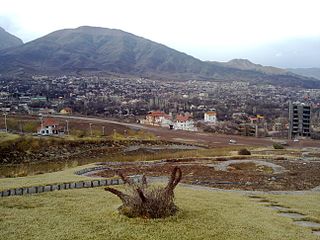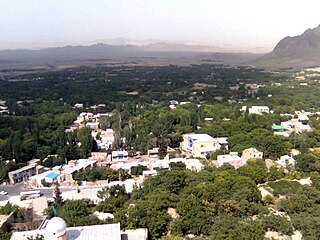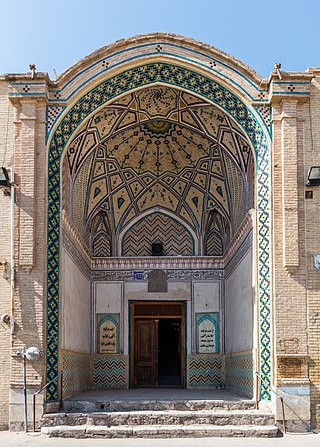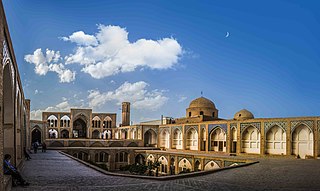
Isfahan or Esfahan/Espahan province is one of the 31 provinces of Iran. Its capital is the city of Isfahan.

Kashan is a city in the Central District of Kashan County, in the northern part of Isfahan province, Iran, serving as capital of both the county and the district.

Qamsar is a city in, and the capital of, Qamsar District of Kashan County, Isfahan province, Iran. The district is 15 km south of Kashan.

Kashan County is in Isfahan province, Iran. Its capital is the city of Kashan.

Neyasar is a city in, and the capital of, Neyasar District of Kashan County, Isfahan province, Iran. It also serves as the administrative center for Neyasar Rural District. The village of Neyasar was levated to the status of a city in 1997.
Meshkat is a city in the Central District of Kashan County, Isfahan Province, Iran, serving as the administrative center for Miyandasht Rural District.
Meymeh is a city in the Central District of Meymeh and Vazvan County, Isfahan province, Iran, serving as capital of the county. It is in the vicinity of the arterial road of Tehran-Isfahan.
Qamsar District is in Kashan County, Isfahan province, Iran. Its capital is the city of Qamsar. A mine in the area has been an important source of cobalt probably since ancient times.
Neshlaj is a village in Neyasar Rural District of Neyasar District, Kashan County, Isfahan Province, Iran.

The Jalali Castle is located in Kashan, Iran.

The Jameh mosque of Kashan is the oldest historical structure in Kashan, Iran. Its only brick minaret is located in its southeastern corner. On the bottom part of the minaret, there is a kufic inscription made by embossed brick. On the inscription, it is mentioned the construction date of the minaret, which is 1074 AD. The minaret is the third oldest minaret in Iran, which has an inscription.
The Meydan Mosque is a historical mosque in Kashan, Iran. It is located in the southern side of the Sang-e Ghadimi square and beside the Bazaar of Kashan. It is one of the oldest structures in Kashan. The primary structure belonged possibly to the seljuq era, but it was destroyed by the Mongols during their invasions. Later it was rebuilt and repaired by Khaje Emad ed-Din. A quotation for this matter is an inscription in the old mihrab, in which it is mentioned that it is built in 623 Hijri by Hassan ebn-e Arabschah in Kashan. The mihrab was in its original place until the last century, but it is kept now in the Museum of Islamic art in Berlin.
The Tabriziha Mosque is a historical mosque in Kashan, Iran. The mosque is located in Malek bazarche and belongs to the Qajar era. It was built by Mohammad Hosseyn Tabrizi. Both sides of its big door have been decorated with haftrang tiles. Its vestibule has a stucco inscription. The ceiling of its shabestan has 18 arches, which have been decorated with bricks and tiles. The columns have been covered with tiles. The four sides of shabestan and around the columns there are inscriptions of the verses of Koran. The inscriptions have been written in white Naskh on a persian blue background. The triangle under the inscriptions have been decorated with designs and shapes. The mihrab of the mosque has been decorated with tiles and has a stucco inscription. On the inscription, some Koran verses have been written in white Thuluth script on the ultramarine background.

The Emamzadeh Ebrahim is a historical structure in Kashan, Iran. The Emamzadeh belongs to the Qajar era. It is well known for its turquoise dome, tiled minarets, pleasant yard and beautiful iwan. Paintings, tiles and decorations with cut mirrors have been added later in the early 20th century.
Emamzadeh Taher and Mansour is a historical structure in Kashan, Iran. The construction of the building was completed in 1536, which is mentioned on the door of the tomb under the name of twelve shiites Imams. The Emamzadeh has a turquoise dome and minaret and also a wooden shrine.

The Mausoleum of Shah Abbas I is the burial place of Abbas I, the Safavid king of Persia. The mausoleum is located in Kashan, Iran. According to the dates on the mihrab of the tomb, the primary structure was built before 12th century. The structure was expanded in the Safavid era. In the southwestern portico, there is a rectangular stone, which originates in Caucasus.
The Chehel Dokhtaran mausoleum is a historical structure in Kashan, Iran. It is located to the west of Emamzadeh Soltan Mir Ahmad. The mausoleum was built in the Ilkhanid era. Its high simple unadorned dome is the hallmark of the architecture in the Ilkhanid era.

The Khwaja Tajuddin Mausoleum, sometimes known as Khaje Taj od-Din Mausoleum is a historical religious complex located next to the Agha Bozorg Mosque in Fazel-e Naraghi district of Kashan, Iran. It was built in the 15th century over a Seljuk-era structure by the Timurid dignitary, Khwaja Zaynuddin, around the grave of his brother. It is number 400 on the list of Iran's national monuments.
The Zeyn od-Din minaret is a historical minaret in Kashan, Iran. The founder of the minaret, Khaje Zeyn od-Din, was one of the dignitaries of the Timurid era in the 15th century. He also built a khanqah beside the minaret. It seems that minaret was originally 47 m high, but more than half of it was destroyed in 1931 by the decision of the governor and mayor of Kashan. Strong earthquakes during the centuries made the minaret lean.

The Shrine of Abu Lu'lu'a, also known as the Shrine of Bābā Shujāʿ al-Dīn is a mausoleum built over what is popularly believed to be the final resting place of Abu Lu'lu'a Firuz, a Persian slave who assassinated the second Islamic caliph Umar ibn al-Khattab in 644.











